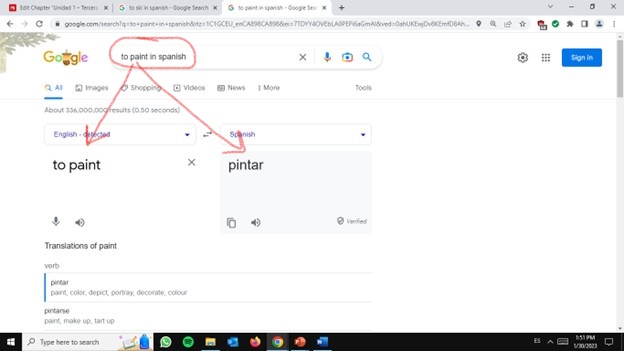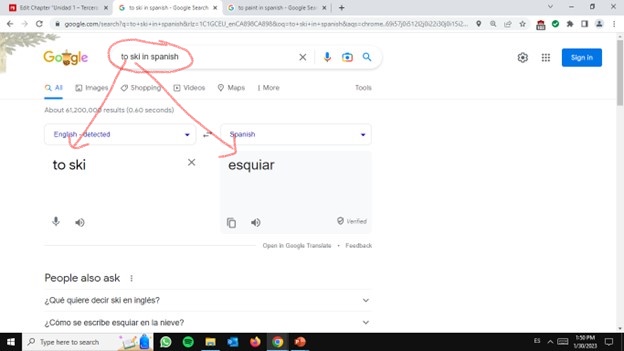Unidad 2 – Tercera Parte (Part 3)
Vocabulario
(Vocabulary)
Las actividades (Activities)
1. Las actividades en la casa (Activities at home)
Click on the vocabulary list of las actividades en la casa below to learn what they mean in English.
2. Las actividades en la universidad (Activities at the university)
Click on the vocabulary list of las actividades en la universidad below to learn what they mean in English.
3. Otras actividades (Other activities)
Click on the vocabulary list of otras actividades below to learn what they mean in English.
¡IMPORTANTE!
- Las actividades son verbos.
- Notice that all actividades above are verbos en infinitivo.
¡A practicar! (Let´s practice!)
Expand your vocabulary of actividades en infinitivo en español (activities in Spanish in the infinitive) that are relevant to you by doing a Google search in English as follows:
By adding "to" in your search in English, you will gain knowledge of both the vocabulary word in Spanish and its form in infinitivo.
Commit yourself to create a list of actividades en infinitivo en español and memorize them. This will be very useful as you will soon learn how to conjugate these actividades en presente simple indicativo (simple present tense) and other tenses.
¡Más práctica! (More practice!)
Ahora watch the video below of the song Nunca el tiempo es perdido (Time is Never Waisted) del cantante español Manolo García and make a list of 10 actividades en el infinitivo that you see in the video. Also, make a list of 10 objetos that you also see in the video.
Copy and paste the following letters and symbols as needed.
á é í ó ú ñ Á É Í Ó Ú Ñ ¡ ! ¿ ?
Cómo usarlo
(How to use it)
1. Tener que (Must, to be obligated to)
La expresisón tener que means obligation or necessity. You can say what actividades you must do by using la expresión Yo tengo que followed by una actividad en infinitivo as learned above.
- En la casa...
- En la casa yo tengo que cocinar.
- En la casa yo tengo que limpiar.
- En la casa yo tengo que dormir.
- En la universidad...
- En la universidad yo tengo que estudiar.
- En la universidad yo tengo que hacer la tarea.
- En la universidad yo tengo que escuchar la clase.
- Otras actividades...
- Yo tengo que ir al supermercado.
- Yo tengo que hacer ejercicios.
- Yo tengo que trabajar.
2. Me gusta (I like)
La expresisón me gusta means to like something. You can say what actividades you like by using la expresión Me gusta followed by una actividad en infinitivo as learned above.
- En la casa...
- En la casa me gusta escuchar música.
- En la casa me gusta mirar la televisión.
- En la Universidad...
- En la universidad me gusta conversar.
- En la universidad me gusta leer.
- Otras actividades...
- Me gusta correr.
- Me gusta dormir.
- Me gusta comer.
¡A practicar! (Let´s practice!)
Tengo que (I must)
You were asked to expand on actividades en español en infinitivo that are relevant to you. Using la expresión tengo que studied above write down actividades that you must do en la casa, en la universidad, and otras actividades. Follow the table below as a model.
á é í ó ú ñ Á É Í Ó Ú Ñ ¡ ! ¿ ?
| En la casa... | En la universidad... | Otras actividades... |
|---|---|---|
Me gusta (I like)
Now, using la expresión me gusta also studied above, follow the table below as a model and write down actividades that you like to do en la casa, en la universidad, and otras actividades.
| En la casa... | En la universidad... | Otras actividades... |
|---|---|---|
Gramática
(Grammar)
1. La expresión "tener que" (The expression "tener que")
En la unidad 1, you learned how to conjugate el verbo tener en presente simple indicativo and how to use it with los años de edad y la posesión de objetos.
En el vocabulario above you learned la expresión tener que used with el pronombre personal yo as in:
- Yo tengo que limpiar mi casa.
¡IMPORTANTE!
La expresión tener que can be applied to other peoples' obligations by conjugating el verbo tener en el presente simple indicativo as well.
Listen to the audio below as I use the picture of la fiesta de la quinceañera to describe some obligations la chica quinceañera tiene que hacer en su día de cumpleaños:
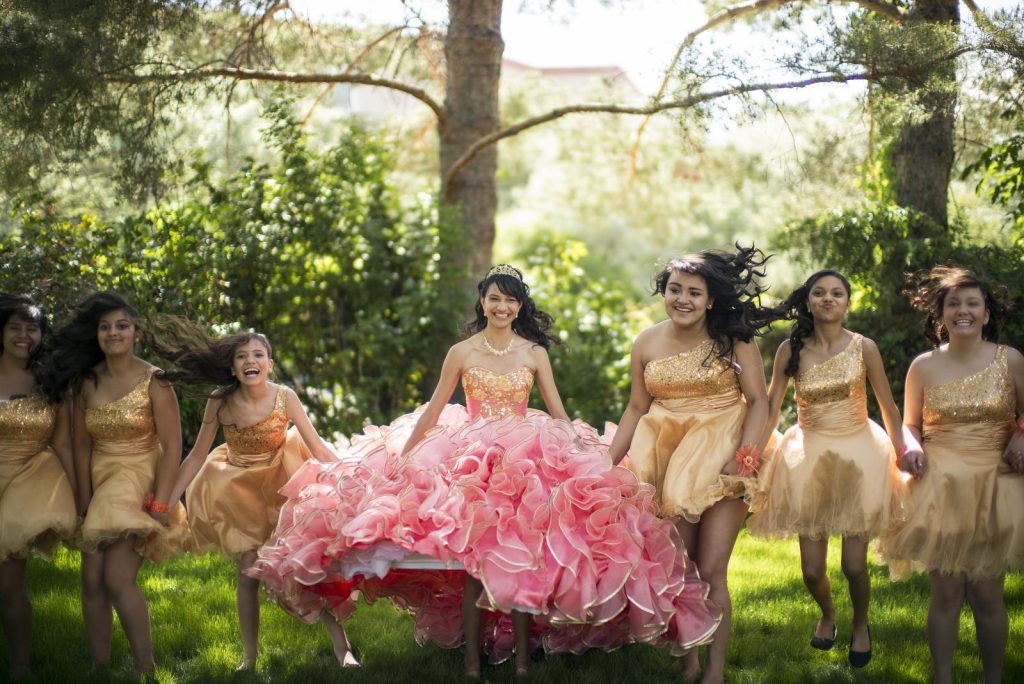
Hoy es el cumpleaños de la chica en la fotografía. Ella cumple 15 años.
¿Qué actividades tiene que hacer la chica?
La chica tiene que celebrar porque es su cumpleaños. Ella tiene que vestir un vestido muy bonito y ella tiene que bailar con su música favorita. Ella tiene que cantar también. Ella tiene que socializar con sus amigas y amigos. Las amigas de la chica en la fotografía tienen que ayudar a la chica en su fiesta de 15 años. Por ejemplo, ellas tienen que tomar fotos y tienen que acompañar a la chica en su fiesta de la quinceañera.
¡A practicar! (Let´s practice!)
Using the description above sobre la chica quinceañera as a model to talk about other people's obligations, think of un miembro de tu familia y write down 5 actividades that this person must do en la casa and in any other place that might be relevant for this miembro de tu familia.
Remember to use el verbo tener conjugated in presente simple indicativo followed by que and by una actividad en infinitivo en español just like you studied above to express obligation.
Copy and paste the following letters and symbols as needed.
á é í ó ú ñ Á É Í Ó Ú Ñ ¡ ! ¿ ?
2. La expresión "me gusta" (The expression "me gusta")
En el vocabulario above you learned la expresión me gusta to express that you like and activity as in:
- En la casa me gusta cocinar.
- En la universidad me gusta estudiar.
In addition to like actividades la expresión me gusta can also be used to like objetos.
- Me gusta mi computadora. (I like my computer)
- Me gusta mi teléfono celular. (I like my cell phone)
- Me gusta el vestido de la quinceañera. (I like the quinceañera's dress)
¡ATENCIÓN!:
If you like 2 or more objetos, personas, or eventos, la expresión me gusta changes to me gustan as in:
- Me gustan mis libros. (I like my books)
- Me gustan mis amigas. (I like my friends)
- Me gustan las fiestas. (I like parties)
¡IMPORTANTE!
When you like 2 or more actividades la expresión me gusta does not change as in:
3. El presente simple indicativo del verbo "gustar"
(Simple present tense of verb "gustar")
Las expresiones me gusta y me gustan are part of the infinite verb gustar in Spanish.
The following table shows you how to conjugate el verbo gustar en presente simple indicativo en español:
| Optional Indirect Pronouns | Gustar | Actividades | Objetos |
|---|---|---|---|
| A mí | me gusta me gustan |
caminar | mi computadora mis audífonos |
| A ti | te gusta te gustan |
caminar | tu computadora tus audífonos |
| A él A ella A usted |
le gusta le gustan |
caminar | su computadora sus audífonos |
| A nosotros A nosotras |
nos gusta nos gustan |
caminar | nuestra computadora nuestros audífonos |
| A ustedes A ellos A ellas |
les gusta les gustan |
caminar | su computadora sus audífonos |
Because in Spain and Equatorial Guinea ustedes changes to vosotros y vosotras the optional indirect pronoun les changes to os.
¡ATENCIÓN!
When you use el verbo gustar, the optional indirect pronouns are not mandatory but they have 2 functions when they are used in a conversation.
The first function puts emphasis on the person who likes something or finds something pleasing as in:
- A mí me gustan los chocolates (Chocolates are pleasing to me)
- A ti te gusta mirar la televisión (Watching tv is pleasing to you-informal)
- A ellos les gusta cocinar en la casa (Cooking at home is pleasing to them)
The second function provides clarification about who the person likes or what the person finds pleasing as in:
- A mi abuela le gusta leer en la casa (My grandmother likes to read at home)
- A mis primas les gustan los libros (My female cousins like books)
- A usted le gusta pintar (You-formal like to paint)
Cómo usar Gustar
(How to use Gustar)
1. To express what I like
- Me gusta cocinar en mi casa / A mí me gusta estudiar en mi casa (a mí is optional but it provides emphasis or clarification that I like to cook at home)
- Me gusta estudiar y leer en la universidad / A mí me gusta cocinar y leer en la Universidad
- Me gusta mi computadora portátil / A mí me gusta mi computadora portátil
- Me gustan mis audífonos / A mí me gustan mis audífonos
2. To express what others like
We can do this in 2 ways.
| Clarifying or giving emphasis about who is the person who likes something: | To talk about what a person likes without emphasis or clarification: |
|---|---|
|
|
3. To express what I do not like and what others do not like
As you learned before, you can make negative sentences by adding “no” before a verb. When using el verbo gustar en presente simple indicativo "no" goes in front of me gusta, te gusta, le gusta, nos gusta, les gusta.
- No me gusta cocinar en mi casa / A mí no me gusta cocinar en mi casa
- No te gusta estudiar / A ti no me gusta estudiar
- No le gusta cocinar / A mi esposo no le gusta cocinar
¡A escuchar! (Let's listen!)
Listen to el video below and learn what Cristina likes and dislikes:
¡A practicar! (Let´s practice!)
Cristina finishes el video by asking you: ¿y a ti, qué te gusta? (and you, what do you like?)
Answer to Cristina by filling out the table below using me gusta / me gustan and no me gusta / no me gustan. Remember to use actividades y objetos that are relevant to you.
Copy and paste the following letters and symbols as needed.
á é í ó ú ñ Á É Í Ó Ú Ñ ¡ ! ¿ ?
| me gusta... | no me gusta... | me gustan... | no me gustan... |
|---|---|---|---|
¡Más práctica! (More practice!)
Copy and paste the following letters and symbols as needed.
á é í ó ú ñ Á É Í Ó Ú Ñ ¡ ! ¿ ?
| Le gusta... / Le gustan... | No le gusta.../ No le gustan... |
|---|---|
4. Otros verbos similares a Gustar (Other verbs similar to Gustar)
In addition to gustar, el español has other verbs through which we can express gustos and disgustos in relation to objetos or actividades. Look at the table below to study them and learn what they mean in English:
| Verbos para expresar gustos | Verbos para expresar disgustos | ||
|---|---|---|---|
| gustar | to like, to be pleasing | disgustar | to dislike, to be displeasing |
| interesar | to be interesting | molestar | to bother |
| encantar | to love | cargar | to be annoying |
| fascinar | to be fascinating | faltar | to be lacking |
| importar | to be important |
Because all these verbs are used to express degrees of likes and dislikes, el verbo gustar en el presente simple indicativo becomes the basis to conjugate all these verbs as well.
In the following table, each verb speaks about a person´s degrees of likes or dislikes in relation to an object or an activity, but the structure of conjugation remains the same as with el verbo gustar studied above.
| Optional Indirect Pronouns | Verbs that express likes and dislikes | |
|---|---|---|
| A mí | me gusta me gustan |
la computadora los audífonos |
| A ti | te fascina te fascinan |
la computadora los audífonos |
| A él A ella A usted |
le interesa le interesan |
la computadora los audífonos |
| A nosotros A nosotras |
nos molesta nos molestan |
la computadora los audífonos |
| A ustedes A ellos A ellas |
les importa les importan |
la computadora los audífonos |
¡A practicar! (Let´s practice!)

¡Hola! ¿Qué hay de nuevo?
A mí me gusta meditar y me gusta pintar. A mí me encanta hacer yoga también. A mí no me gusta cocinar y no me gusta trabajar. A mí me encanta escuchar música y me fascina bailar. A mí me interesa estudiar lenguas. A mí me importa la naturaleza. A mí no me gustan los audífonos porque (because) son incómodos. A mí no me interesan las calculadoras tampoco. A mí me molestan los políticos.
Ahora, use la descripción above as a model for you to describe degrees of likes and dislikes in relation to objetos y actividades that are meaningful to you. Remember to write en español in full sentences and use la gramática learned of los verbos gustar and similar verbs studied above.
Copy and paste the following letters and symbols as needed.
á é í ó ú ñ Á É Í Ó Ú Ñ ¡ ! ¿ ?
Cultura hispanohablante
(Spanish-speaking Culture)
La sociabilización en el mundo hispanohablante
(Socialization in the Spanish-speaking world)
Like la familia sociabilizar es importante en el mundo hispanohablante. Entonces, las familias en el mundo hispanohablante tend to share similar expectations about la sociabilización with others.
- A las personas hispanohablantes les gusta sociabilizar a menudo.
- A las personas hispanohablantes les gusta sociabilizar con muchos familiares[1], amigos y amigas.
- A las personas hispanohablantes les gusta coversar mucho y pasarlo bien.
When socializing, las personas hispanohablantes greet each other with a kiss[2] and with a hug.
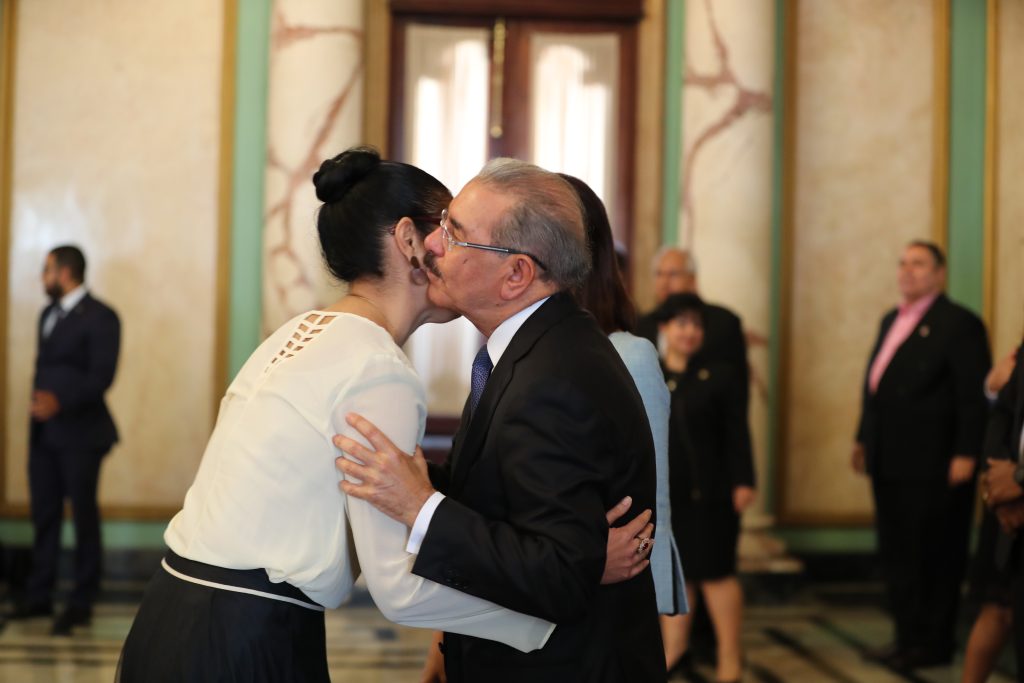
When socializing, las personas hispanohablantes prefer poco espacio personal (low-personal space). This means that las personas hispanohablantes prefer to interact at a close distance and frequently touch one another while socializing.
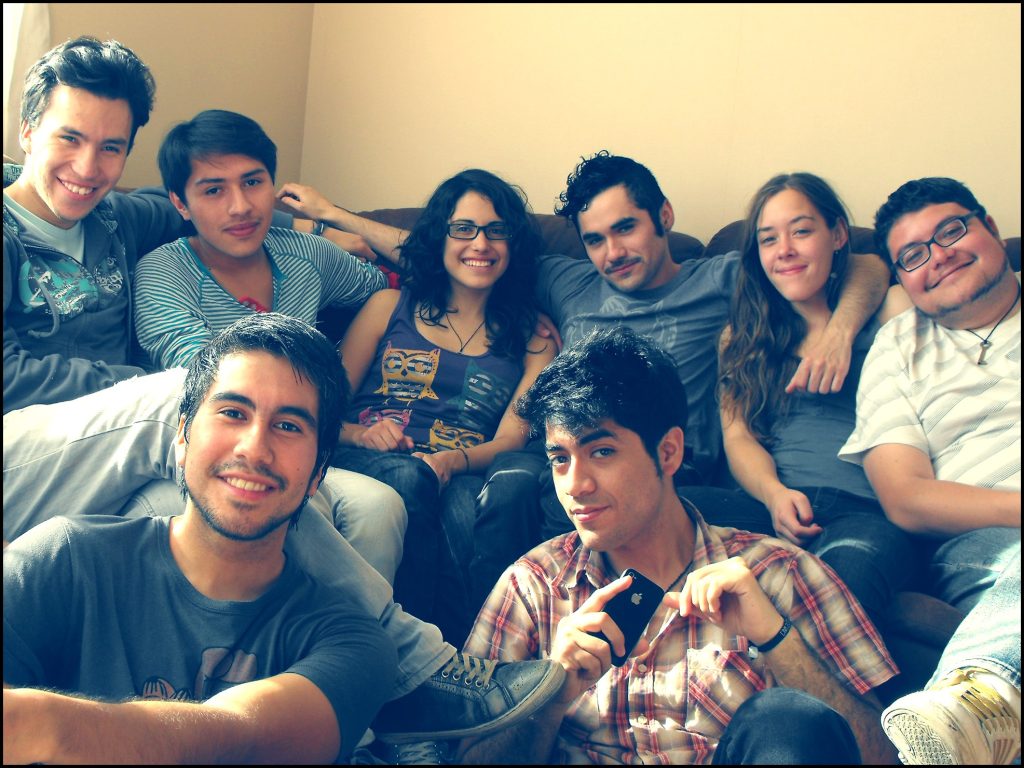
When socializing, las personas hispanohablantes use muchos non-verbal behaviours (NVBs) because they tend to be more emotionally expressive when interacting with others.
Watch the following video to observe how the former president and current vice-president of Argentina, Cristina Kirchner, interacts with others and how others interact with her by using NVBs:
En mi opinión...(In my opinion…)
What about en tu cultura?
¿Es importante sociabilizar en tu cultura? Do you share similar expectations about la sociabilización en el mundo hispanohablante within your culture or country where you live? Reflect in English.
Media Attributions
- Screenshot of Google search to paint © Constanza Rojas-Primus is licensed under a CC BY-NC (Attribution NonCommercial) license
- Screenshot of Google search to ski © Constanza Rojas-Primus is licensed under a CC BY-NC (Attribution NonCommercial) license
- Quinceañera. Santa Fe © Christopher Michel is licensed under a CC BY (Attribution) license
- La profesora Constanza Rojas-Primus © Constanza Rojas-Primus is licensed under a CC BY-NC (Attribution NonCommercial) license
- Saludo de beso © Gobierno Danilo Medina is licensed under a CC BY-NC-ND (Attribution NonCommercial NoDerivatives) license
- Grupo © Danilo Urbina is licensed under a CC BY-NC-ND (Attribution NonCommercial NoDerivatives) license
verbs are words that represent an action or activity. For example: "to sing" is an action in infinitive form. In the sentence "I sing" the action is conjugated in the present indicative. In the sentence "I sang" the action is conjugated in past tense.
infinitive, any verb or action that is preceded by the word 'to' in English is an infinitive. For example: to love, to eat, to run, to be, to believe, to follow, to laugh, etc. This means that the actions are not yet conjugated in the present tense or in any other tense.
now
singer
objects
I must
for example
I like
the years of age
and
the possession, ownership
must, to be obligated to
I
also
you - informal
you - formal
must do
today
the photograph, the picture
from the verb in the infinitive "cumplir" meaning to turn years.
because
her, his, your-formal, your-plural, and also, its for a non-human being
very
about
a member
activities
the dress
attention!
persons
events
I like 2 or more (something)
important!
to sing
to read
to clean
to listen
to like
present simple indicativo (simple present tense)
you-all
you-all for all males/mixed in Spain and Equatorial Guinea
you-all for all females in Spain and Equatorial Guinea
I do not like
I do not like 2 or more (something)
the video
likes
dislikes
languages
nature
unconfortable
either
politicians
description
to socialize
then, hence
socialization
often
with
a lot, plural
relatives
have fun
little
your-informal

